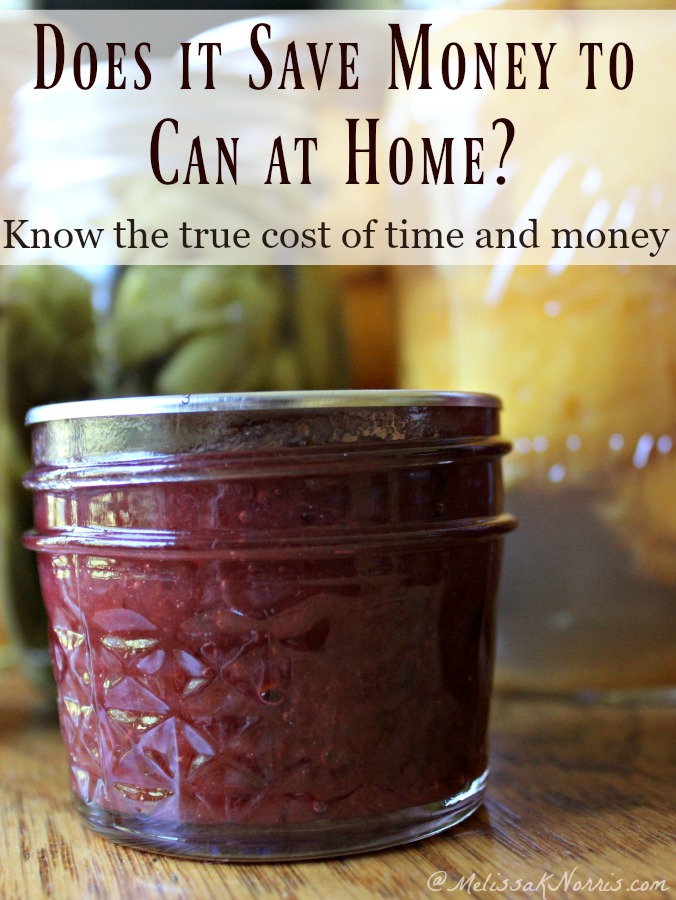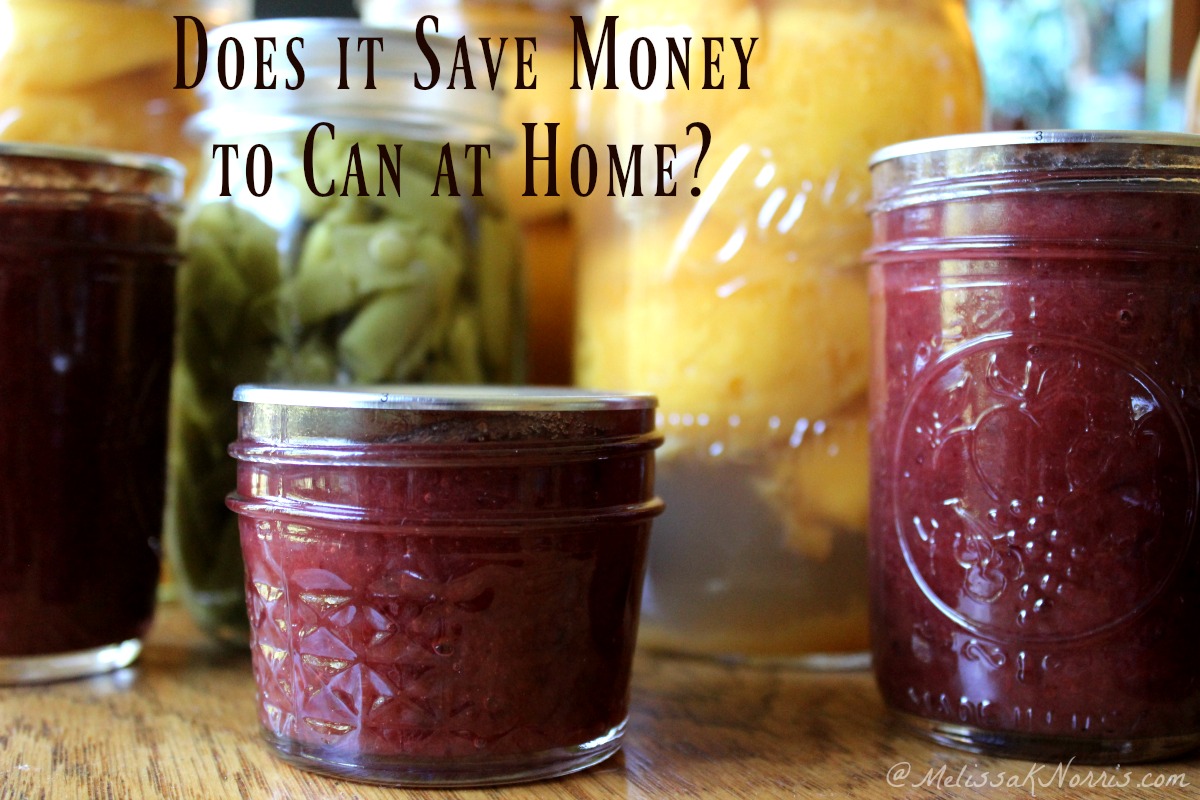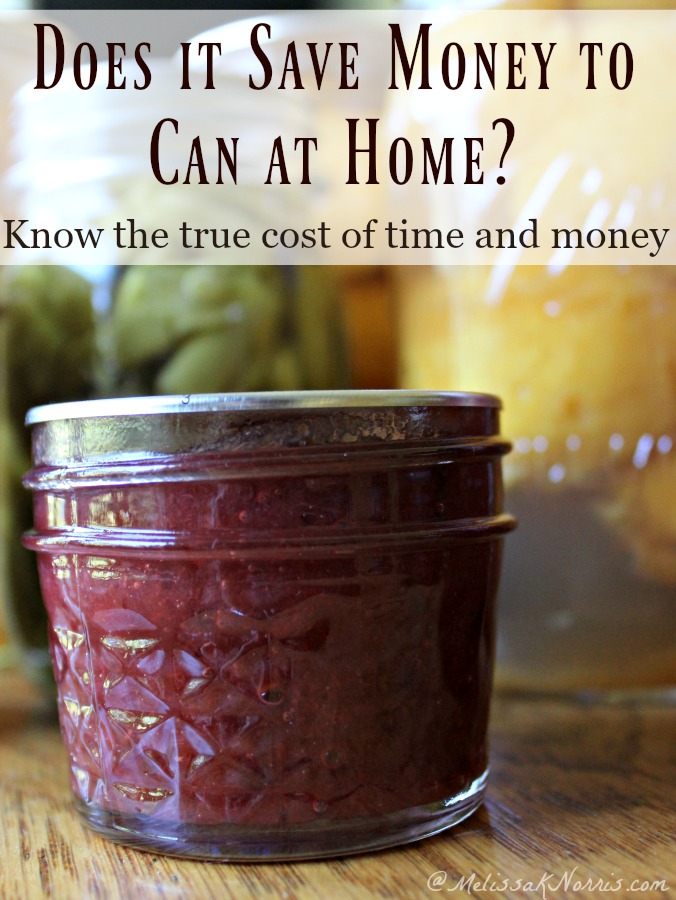Does canning food at home really save you money? Home canning is a wonderful old-fashioned tradition. Many people remember their grandma or great-grandma canning and want to learn how to can, but they wonder, is it really worth it.

Listen to this post Episode #88 (just push play below) and all our episodes of the
Pioneering Today Podcast while you’re on the go, scrubbing the house, cooking up dinner (can I get an invite?), or mucking out stalls! I post new episodes Friday mornings. You can subscribe via RSS and receive every episode for free.![]()
Or subscribe via Itunes
 Just as I have answered the questions, “Does homesteading really save money?”, and “Does gardening save money?”, you can rest assured, that canning is worth it. There’s several things we have to consider, for one, you have to compare things realistically and item for item.
Just as I have answered the questions, “Does homesteading really save money?”, and “Does gardening save money?”, you can rest assured, that canning is worth it. There’s several things we have to consider, for one, you have to compare things realistically and item for item.
Cost of Canning Equipment
First off, there is the cost of the jars, I just purchased a case of jars brand new for $8.99 a dozen from our local hardware store, which did include the bands and lids, but we’ll only be reusing the bands and the jars. Divide that and it’s $.75 a jar for the first year. I have some jars that are over 15 years old I’m still using, so that would bring them down to $.05 a jar.
Better yet, you can often get used canning jars from friends, family, neighbors, garage sales and thrift stores, bringing the cost of them to almost pennies if you reuse them. When purchasing used jars, make sure you run your finger over the rim of the jar to make sure there aren’t any nicks or cracks, which inhibits them from sealing properly.
Next we have the cost of the lids. Regular lids are usually $1.99 a box where I live, making them roughly $.16 a piece, so that puts us at about $.20 cents a jar for the lid and jar cost. If you use Tattler lids, (How to Use Tattler Lids) the only safe reusable canning lid (regular mouth for a box of 12 is $9.00), brings the first use to $.75 a lid, but depending upon the number of years you reuse the bands, you can bring your cost to $.15 a jar in 5 years or just $.07 in 10 years.
Price Comparison of Home Canned Food to Store Bought
Now to compare the true cost of the jar filled with food you have to compare oranges to oranges, or in this case, green beans to green beans. The green beans I grow are an heirloom variety and totally organic. They’re allowed to mature on the vine, hand picked, and processed and canned the day they’re picked. This means no nutrient loss due to time off the jar and sitting before being processed. They’re in a glass jar, not a metal jar that could leach questionable ingredients into the finished product.
Same thing with my home canned tomato products. Organic, vine ripened (hello, better flavor, you haven’t lived until you taste tomatoes ripened on the vine like they’re supposed to be and then turned into sauce), and processed on picking day, in a glass jar.
Many times I see price comparison done with the cheapest can someone can find, and that’s not a true price comparison. Where I live, that jar of tomato sauce is upwards of $4 a jar in the glass.
Now if you plan on canning vegetables, you will need a pressure canner (see which is the best pressure canner) and that is an expense. I started out with an $80 pressure canner over 16 years ago, which is $5 a year and when you divide that by 300 jars a year, the cost is a penny per jar for the pressure canner.
My husband got me the All American Pressure Canner this past year, which allows me to can over twice as many jars at once (still one of the best Christmas presents ever!). Even with the higher price tag, over 16 years, and I plan on getting a lifetime out of it, it still equals out to $16 a year, going down every additional year you use it.
I’m not saying a pressure canner isn’t an investment, but when you count up how much you’d spend out going out to eat over a year, that pressure canner is paid for and then some.
The cost of produce or ingredients for canning is definitely a factor. Here on our homestead we grow the majority of things we can at home, from enough tomatoes to make all of our tomato sauce, stewed tomatoes, and salsa for the year, to green beans, blueberries and raspberries for jams and jellies, and blackberries for syrups.
The produce I still purchase to can up things at home are peaches (I can buy a box or approximately 2o pounds of peaches for $18), a few peppers for salsa, concentrated lemon juice and vinegar, strawberries, and asparagus. I purchase in season and when buying in bulk and from a local farmer, I pay much less than I would at the grocery store, especially in the middle of winter which is when we rely on our home canned goods.
If you’re growing the produce at home and canning it, then the price is less than $.25 a jar, if you’re purchasing the produce, it will vary, but usually it’s still going to be less than $2.00 per jar of finished product. But don’t discount the price savings by purchasing it in bulk and in season.
How much time does it take to can food at home
We’d be amiss if you we didn’t talk about the time cost for canning food at home. It does take time, not gonna lie. However, I still can over 300 jars every year while working as a pharmacy tech outside the home, blogging, writing, and doing the podcast with a fully operating homestead. So it can be done, even if you work full time.
In August, I sometimes can a run of food in the morning before work and get up an hour earlier in order to do so.
The amount of time varies by food, processing time, and method. It’s actually faster for me to raw pack and pressure can my vegetables than it is to make jams and jellies or sauces.
However, by canning, I’m taking the same amount of time to process and prep up to 19 jars of food in one sitting, if I”m running my full load of pint jars in the All American Canner. Come winter time all I have to do is open up the jar, heat, and eat (depending upon the contents). It’s actually faster to can than it is to cook all of those items fresh at meal time. Canning is the ultimate batch cooking!
Does it Save Money to Can at Home
Yes, it absolutely does if you’re properly comparing the same home canned goods to the store bought comparison. If you’re comparing it to the cheapest canned food you can find and are only taking into consideration the price and not growing any of the food at home, then maybe not.
With home canning, you’re also controlling the ingredients going into your food. I don’t want high fructose corn syrup, GMO’s, insane amounts of sugar, and other preservatives going into the food I eat and feed my family. In fact, my health demands it. After having a scare and battling with stomach issue, the only way I’ve been able to keep a handle on it is by cutting out these items in our food.
I believe you need to count the health costs as well when comparing.
Is it worth it to can food at home?
Yes, Mason jars raised high in both hands, yes.
Having shelves lined with food that isn’t dependent upon on a grocery store and I know exactly what is in them is a feeling like no other. I can literally go grocery shopping from my own pantry during an emergency, bad weather, if the power goes out I don’t have to worry about it going bad, or if and when money gets tight, I know I’ve got jars of food ready to eat.
Plus, on a busy night, no fast food or worrying about dinner, I can open a jar and have a homemade home-cooked meal on the table in 10 or 15 minutes.
I’ve created a special FREE 5 video series to help you achieve this, to get access click here–> 5 FREE videos on Self-Sufficiency and Safe Canning
Access Your Self-Sufficiency Videos Now




